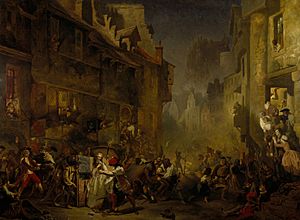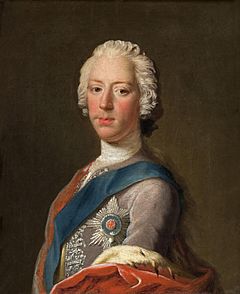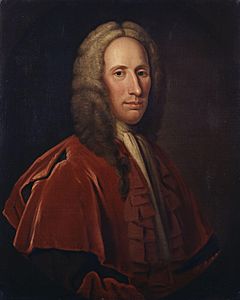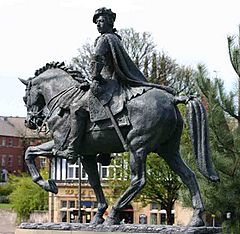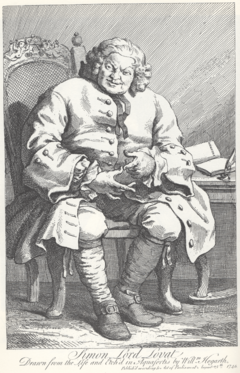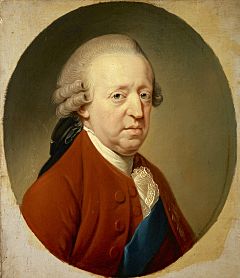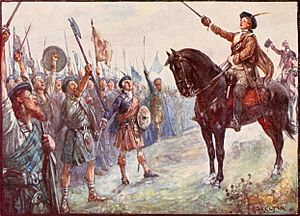Jacobite rising of 1745 facts for kids
Quick facts for kids Jacobite rising of 1745 |
|||||||
|---|---|---|---|---|---|---|---|
| Part of the Jacobite risings | |||||||
 An Incident in the Rebellion of 1745, David Morier |
|||||||
|
|||||||
| Belligerents | |||||||
| Commanders and leaders | |||||||
|
|||||||
The 1745 Jacobite Rebellion, also known as the Forty-five or the '45, was an attempt by Charles Edward Stuart to help his father, James Francis Edward Stuart, become the King of Great Britain again. This rebellion happened during a big war in Europe called the War of the Austrian Succession. Most of the British army was fighting in Europe at the time. The '45 was the last in a series of rebellions that started in 1689. Other major uprisings happened in 1715 and 1719.
Charles started the rebellion on August 19, 1745, at Glenfinnan in the Scottish Highlands. His forces quickly captured Edinburgh and won a battle at Prestonpans in September. In October, Scottish leaders agreed to invade England. Charles promised them strong support from English Jacobites and a French army landing in Southern England. The Jacobite army entered England in early November. However, neither of Charles's promises came true. When they reached Derby on December 4, they stopped to decide what to do next.
Similar talks had happened in Carlisle, Preston, and Manchester. Many felt they had already gone too far. The invasion route was chosen to go through areas thought to support the Jacobites. But the promised English help never appeared. With several government armies closing in, the Jacobites were outnumbered and in danger. Most of the army leaders decided to retreat. This decision caused a lasting disagreement between Charles and his Scottish supporters. Even though they won a battle at Falkirk Muir in January 1746, the Jacobites were defeated at Culloden in April. This ended the rebellion. Charles escaped to France but could not get support for another attempt. He died in Rome in 1788.
Contents
Why the Rebellion Happened
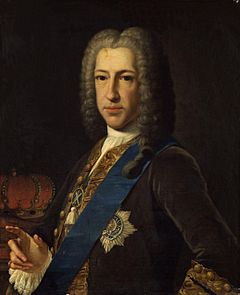
In 1688, a big change called the Glorious Revolution happened in Britain. The Catholic King James II was replaced by his Protestant daughter Mary and her Dutch husband William. They ruled together. Neither Mary nor her sister Anne (who became queen in 1702) had children who lived. This meant their Catholic half-brother James Francis Edward was the closest natural heir. However, a law from 1701, the Act of Settlement 1701, said that Catholics could not be king or queen. So, when Queen Anne died in 1714, her distant Protestant cousin, George I, became king.
Louis XIV of France, who had supported the exiled Stuarts, died in 1715. His successors in France needed peace with Britain to rebuild their country. An agreement between Britain and France in 1716 forced James to leave France. He settled in Rome and received money from the Pope. This made him less appealing to the Protestants who made up most of his British supporters. Jacobite rebellions in 1715 and 1719 both failed. After these failures, many senior exiles returned home or found other work. James's sons, Charles and Henry, helped keep public interest in the Stuarts alive. But by 1737, James had given up hope of becoming king again.
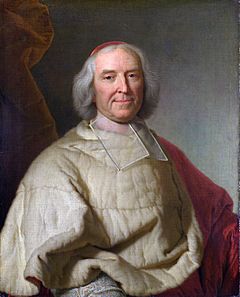
By the late 1730s, French leaders saw Britain's growing trade power as a threat. They thought the exiled Stuarts could be a way to weaken Britain. It was cheaper to support a small rebellion than a full restoration of the Stuarts. The remote Scottish Highlands were a good place to start such an attempt. The clan system there made it easier to gather troops. However, even people who supported the Jacobites were worried about an uprising. They knew it could cause great harm to the local people.
People in Scotland also protested against taxes from the London government. This led to the malt tax riots in 1725 and the Porteous riots in 1737. In 1743, a Scottish army group, the 42nd Regiment of Foot, was sent to fight in Europe. This was against what they understood about their service. It caused a short mutiny. But protests about pay and conditions were common. The worst riots in 1725 happened in Glasgow. Charles later noted that Glasgow was a place where he had no friends.
Trade problems between Spain and Britain led to the War of Jenkins' Ear in 1739. Then came the War of the Austrian Succession in 1740–41. Britain's long-serving prime minister, Robert Walpole, had to resign in 1742. Some British politicians, like the Duke of Beaufort, asked France for help to put James back on the British throne. War with Britain was likely. But Cardinal Fleury, France's chief minister, thought the Jacobites were unreliable. Most French ministers agreed. However, the Marquis D'Argenson, who became Foreign Minister in 1743, was an exception.
Jacobite Support in Britain
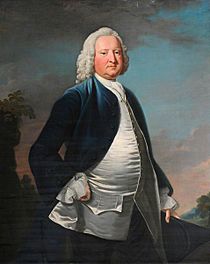
Historians say there were several reasons why people supported the Jacobites in 1745. Loyalty to the Stuart family was actually one of the least important reasons. These different reasons caused problems during the rebellion. Charles himself didn't know much about the countries he hoped to rule. Also, many of his main advisors were Irish exiles. They wanted Ireland to be independent and Catholic. They also wanted lands that had been taken from them to be returned. James II had promised these things for Irish support in earlier wars. Only a Stuart king in Britain could make sure these promises were kept.
However, Protestants, who were the vast majority in England, Wales, and Scotland, strongly opposed these ideas. Many people thought that English people who didn't care for the current king, George I, were actually eager for the Stuarts to return. This wasn't always true. After 1720, Robert Walpole tried to make English Catholics more loyal to the government. He did this by not strictly enforcing laws against them. Many Catholics became government supporters, including the Duke of Norfolk. He was a leader of the English Catholic community. He stayed loyal to King George II during the 1745 rebellion.
Most English Jacobite supporters were Tories. They were upset that they had been kept out of power since 1714. They saw the Hanoverian kings (like George I) as a burden. They felt these kings involved Britain in expensive European wars that didn't help Britain much. These feelings were strong in the City of London. But even this group cared more about protecting the Church of England. This meant defending it from Charles and his Catholic advisors, the Scottish Presbyterians in his army, or other Protestant groups. Many "Jacobite" protests in Wales were actually against the Welsh Methodist revival of the 1700s.
The most famous Welsh Jacobite was Sir Watkin Williams-Wynn. He was a landowner and a Tory Member of Parliament. He met with Stuart agents several times between 1740 and 1744. He promised support if Charles brought a French army. In the end, he stayed in London during the rebellion. Only two Welsh lawyers, David Morgan and William Vaughan, joined the uprising from the Welsh gentry.
After the 1719 Jacobite rebellion, new laws punished clergy who refused to swear loyalty to the Hanoverian king. In Scotland, these clergy kept their independence due to religious differences with the main Church of Scotland. Many who joined the 1745 rebellion came from these non-juring churches. However, the strongest reason for Scottish support in 1745 was opposition to the 1707 Union. Many Scots felt they had lost political control without gaining enough economic benefits. This was especially true in Edinburgh, where the Scottish Parliament used to be. Many Highland chiefs were also deeply in debt.
In short, Charles wanted to rule a united Great Britain. He believed he had a divine right to be king and wanted absolute power. But the 1688 Glorious Revolution had rejected these ideas. His trusted advisors, mostly English or Irish Catholic exiles, supported his views. This was very different from the Scottish Protestant nationalists who made up most of the Jacobite army in 1745. They were against the Union, Catholicism, and "arbitrary" (unlimited) rule. Also, the Jacobite exiles didn't understand that English Tory support came from political differences, not strong loyalty to the Stuarts.
Charles Arrives in Scotland
In 1743, King Louis XV of France and his uncle, Philip V of Spain, agreed to work together against Britain. This included an invasion to put the Stuarts back on the throne. In November 1743, Louis told James that this invasion was planned for February 1744. France started gathering 12,000 troops and ships at Dunkirk. This port was chosen because it was easy to reach the Thames from there. The Royal Navy knew about these plans. So, the French navy in Brest made a show of preparing to sail. They hoped to trick British patrols away.
James stayed in Rome, but Charles secretly went to join the invasion force. However, when the French admiral's ships left Brest in January 1744, the Royal Navy did not follow. French naval operations against Britain often happened in winter. Bad weather made it harder for Britain to block their ships. But this also affected the French. Like in 1719, the invasion force was hit by storms. Several French ships sank, and many others were badly damaged. In March, Louis cancelled the invasion and declared war on Britain.
In August, Charles traveled to Paris. He met Sir John Murray of Broughton, who was the link between the Stuarts and their Scottish supporters. Murray later said he advised against a rebellion without strong French help. But Charles was determined to go, "though with a single footman." When Murray returned to Edinburgh with this news, his friends repeated their opposition to a rising without French military support. Charles gambled that once he was in Scotland, France would have to support him.
In early 1745, Charles bought weapons. A French victory at Fontenoy in April encouraged France to give him two transport ships. These were the 16-gun privateer Du Teillay and the Elizabeth, an old 64-gun warship. The Elizabeth carried weapons and 100 volunteers from the French Army's Irish Brigade. In early July, Charles boarded Du Teillay with seven trusted companions, including John O'Sullivan, an Irish exile and former French officer who became Charles's chief of staff. The two ships left for the Outer Hebrides on July 15. Four days later, they were stopped by HMS Lion, which fought the Elizabeth. After a four-hour battle, both ships had to return to port. Losing the Elizabeth and its supplies was a big problem. But Du Teillay managed to land Charles at Eriskay on July 23.
Many people Charles contacted told him to go back to France. This included MacDonald of Sleat and Norman MacLeod. They knew the severe punishments for failure. They felt Charles had not kept his promises by arriving without French military support. They were also not convinced by his leadership. MacLeod and Sleat later helped Charles escape after Culloden. Donald Cameron of Lochiel only joined after Charles promised to pay him if the rebellion failed.
On August 19, the rebellion officially began. The Royal Standard was raised at Glenfinnan. About 700 Highlanders watched. This small Jacobite force used new government roads to reach Perth by September 4. More supporters joined them there. This included Lord George Murray, who had been pardoned for joining earlier rebellions. O'Sullivan first organized the Jacobite army like a regular army. But when Murray took over, he used traditional Highland military ways. These were more familiar to most of the new recruits.
The senior government legal officer in Scotland, Lord President Duncan Forbes, sent news of Charles's landing to London on August 9. Many of the 3,000 soldiers available to Sir John Cope, the government commander in Scotland, were untrained. Cope didn't have much information on Jacobite plans. But the Jacobites knew a lot about his plans, as Murray had been one of Cope's advisors. Forbes tried to keep people loyal through his relationships. He failed with Lochiel and Lord Lovat. But he succeeded with many others, including the Earl of Sutherland and Clan Munro.
On September 17, Charles entered Edinburgh without a fight. Edinburgh Castle stayed in government hands. James was declared King of Scotland the next day, and Charles his Regent. On September 21, the Jacobites surprised and defeated Cope's army in less than 20 minutes at the Battle of Prestonpans, near Edinburgh. The Duke of Cumberland, commander of the British army in Europe, was called back to London with 12,000 troops. To gain more support in Scotland, Charles published two "Declarations" on October 9 and 10. The first ended the "pretended Union" with England. The second rejected the Act of Settlement. He also had a newspaper publish details of a 1695 investigation into the Massacre of Glencoe. This event was often used to show how harsh the government had been.
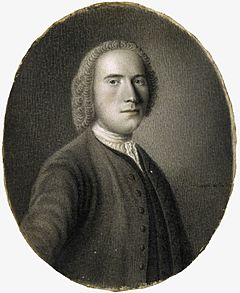
Jacobite spirits were lifted in mid-October when the French sent money and weapons. They also sent an envoy, the Marquis d’Éguilles. This seemed to confirm Charles's claims of French support. However, Lord Elcho later said that his fellow Scots were already worried about Charles's bossy style. They also feared he was too influenced by his Irish advisors. A "Prince's Council" of 15 to 20 senior leaders was formed. Charles didn't like it, seeing it as Scots telling a divinely appointed monarch what to do. The daily meetings also made the disagreements between different groups worse.
These internal tensions were clear during meetings on October 30 and 31 to discuss strategy. Most Scots wanted to strengthen their position in Scotland. They wanted to bring back the Scottish Parliament to help defend against the "English armies" they expected. Charles argued that invading England was vital to get French support. He believed it would ensure an independent Scotland by removing the Hanoverian kings. The Irish exiles supported him. For them, a Stuart on the British throne was the only way to get an independent, Catholic Ireland. Charles also claimed he was in touch with English supporters who were waiting for them. D’Éguilles also told the council that a French landing in England was about to happen.
Despite their doubts, the Council agreed to the invasion. But it was on the condition that the promised English and French support would arrive. Earlier Scottish invasions of England had crossed at Berwick-upon-Tweed. But Murray chose a route through Carlisle and the North-West of England. These areas had strong Jacobite support in 1715. The last Jacobite troops left Edinburgh on November 4. Government forces retook the city on November 14.
Invading England

Murray split the army into two groups to hide their destination from General George Wade, the government commander in Newcastle. They entered England on November 8 without any resistance. On November 10, they reached Carlisle. This was an important border fort before the 1707 Union. But its defenses were now in poor condition, held by only 80 old soldiers. However, without heavy cannons, the Jacobites would have to starve the fort into surrender. They didn't have the right equipment or time for this. Despite this, the castle surrendered on November 15, after learning that Wade's relief force was delayed by snow. This success boosted the Jacobite cause. When he retook the town in December, Cumberland wanted to punish those responsible.
Leaving a small group of soldiers, the Jacobites continued south to Preston on November 26, then Manchester on November 28. In Manchester, they got their first notable English recruits. These formed the Manchester Regiment. Their leader was Francis Towneley, a Catholic from Lancashire and a former French army officer. His older brother had barely escaped punishment for his part in the 1715 Rebellion. At earlier meetings in Preston and Manchester, many Scots felt they had gone far enough. But they agreed to continue when Charles promised that Sir Watkin Williams Wynn would meet them at Derby. He also said the Duke of Beaufort was preparing to take the important port of Bristol.
When they reached Derby on December 4, there was no sign of these extra troops or any French landing in England. The Council met at Exeter House on December 5 to discuss what to do next. Large crowds had come to see them on their march south. But only Manchester provided a good number of recruits. Preston, a Jacobite stronghold in 1715, only gave them three. Murray argued they had gone as far as they could. He said they risked being trapped by larger forces. Cumberland was advancing north from London, and Wade was moving south from Newcastle. Charles admitted he had not heard from the English Jacobites since leaving France. This meant he had lied earlier. His relationship with the Scots was now badly damaged.
The Council voted strongly to retreat. This decision was made even stronger by a report from Lord John Drummond. He said French ships had landed supplies and money at the port of Montrose, Angus. These included "volunteers" from the "Royal Écossais" and the Irish Brigade. These were units of the regular French army. While these troops were less than 200 in total, Drummond supposedly suggested that another 10,000 were preparing to follow. This "greatly influenced" the decision.
People have debated this decision ever since. But at the time, people didn't believe the current government would fall, even if the Jacobites reached London. The decision to retreat was because of a lack of English support and no French landing in England. It wasn't because they were close to the capital. Many modern historians agree it was a wise decision. One reason was that their lack of heavy weapons allowed the Jacobites to out-march their enemies. But it would be a disadvantage in a big battle. In a letter from November 30, the Duke of Richmond, who was with Cumberland's army, listed five options for the Jacobites. Retreating to Scotland was the best for them and the worst for the government.
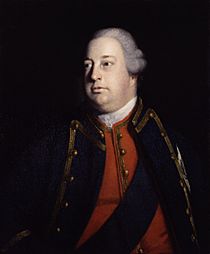
The British government was worried about reports of an invasion fleet being prepared at Dunkirk. But it's not clear how serious these plans were. Over the winter of 1745 to 1746, a French general was gathering troops in Northern France for a planned attack in Europe. Dunkirk was also a major base for privateers (private ships allowed to attack enemy ships) and was always busy. Threatening an invasion was a much cheaper way to make Britain use its resources than actually invading. These plans were officially cancelled in January 1746.
The retreat badly hurt the relationship between Charles and the Scots. Both sides viewed the other with suspicion and anger. Lord Elcho later wrote that Murray believed they could have continued the war in Scotland "for several years." This would have forced the Crown to agree to terms, as its troops were desperately needed for the war in Europe. This seems unlikely. Despite their victories in Europe, France's Finance Minister warned Louis in early 1746 that the British naval blockade had put the French economy in a "catastrophic state."
The fast-moving Jacobite army avoided being caught. There was only a small fight at Clifton Moor. They crossed back into Scotland on December 20. Cumberland's army arrived outside Carlisle on December 22. Seven days later, the Jacobite soldiers there were forced to surrender. This ended the Jacobite military presence in England. Many of these soldiers were from the Manchester Regiment. Several officers, including Francis Towneley, were later punished severely.
The Road to Culloden
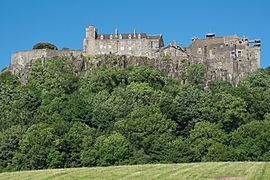
The invasion itself achieved little, but reaching Derby and returning was a great military accomplishment. Spirits were high. More troops from Aberdeenshire and Banffshire joined them. Scottish and Irish soldiers serving in the French army also arrived. This brought the Jacobite army's strength to over 8,000.
The Jacobite army now tried a more traditional way of fighting. They were perhaps not as good at this. Many troops were busy stopping a rebellion in the Highlands. This was led by clans loyal to the government under John Campbell, 4th Earl of Loudoun. At the same time, much of their effort went into besieging Stirling Castle. This was one of the strongest forts in Scotland. On January 17, the Jacobites scattered a government relief force at the Battle of Falkirk Muir. But they didn't have enough heavy cannons, so the siege itself didn't make much progress.
The government forces were mostly intact. They continued their advance once Cumberland arrived in Edinburgh on January 30. Many Highlanders had gone home after Falkirk. On February 1, the Jacobite army gave up the siege and retreated to Inverness. Cumberland marched up the coast, allowing his forces to get supplies by sea. He entered Aberdeen on February 27. Both sides stopped fighting until the weather got better. When Cumberland left Aberdeen on April 8, the Jacobites were low on food and money. Their leaders agreed that fighting a battle was their best choice.

Arguments about whether the ground at Culloden was suitable came from later disagreements between supporters of Murray and O'Sullivan. O'Sullivan was largely responsible for choosing the spot. But the defeat was due to several reasons. Cumberland's troops had more soldiers and better equipment. They had also practiced how to stop the Highland charge. This charge relied on speed and fierceness to break enemy lines. When it worked, it led to quick victories like Prestonpans and Falkirk. But if it failed, the Highlanders couldn't hold their ground.
The Battle of Culloden on April 16 is often called the last major battle fought on British soil. It lasted less than an hour and ended in a clear government victory. Many Jacobites missed the battle because they were tired from a night march. This march was a failed attempt to surprise Cumberland's troops. So, fewer than 5,000 Jacobites faced a well-rested and well-equipped force of 7,000 to 9,000.
The fighting started with an artillery exchange. The government's cannons were much better trained and coordinated. The Jacobite artillery leader was absent, having been wounded earlier. Charles held his position, expecting Cumberland to attack. But Cumberland refused. Unable to respond to the cannon fire, Charles ordered his front line to charge. As they charged, boggy ground in the middle forced them to the right. They got mixed up with the regiments on the right wing. An enclosure wall also limited their movement.
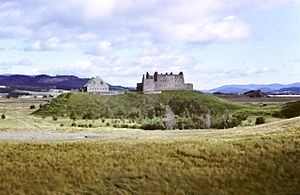
This increased the distance to the government lines and slowed the charge. It also made them exposed to the government's cannons for longer. The cannons now fired grapeshot (small metal balls). Despite heavy losses, the Highlanders crashed into Cumberland's left side. The government line gave ground but did not break. Meanwhile, Loudon's Highlanders fired into the Jacobites' side from behind the wall. Unable to fight back, the Highlanders broke and fell back in confusion. The soldiers from the north-eastern regiments and the Irish and Scots regulars in the second line retreated in good order. This allowed Charles and his personal group to escape north.
Troops that stayed together, like the French regulars, were much safer when retreating. But many Highlanders were cut down during the chase. Government losses were about 50 killed and 259 wounded. Many Jacobite wounded left on the battlefield were reportedly killed afterward. Their losses were 1,200 to 1,500 dead and 500 prisoners. Several thousand armed Jacobites were still free. Over the next two days, about 1,500 gathered at Ruthven Barracks. On April 20, Charles told them to scatter. He said French help was needed to continue the fight. He told them to go home until he returned with more support.
Lord Elcho later claimed he told Charles to "put himself at the head of the [...] men that remained to him, and live and die with them." But Charles was determined to leave for France. After avoiding capture in the Western Highlands, Charles was picked up by a French ship on September 20. He never returned to Scotland. But his relationship with the Scots had already broken down. Even before Derby, he had accused Murray and others of being traitors. These outbursts became more frequent due to disappointment. The Scots no longer trusted his promises of support.
After the Rebellion
After Culloden, government forces spent weeks searching for rebels. They took cattle and burned meeting houses of non-juring Episcopalians and Catholics. The harshness of these actions was partly because both sides widely believed another landing was coming. Regular soldiers who served in the French army were treated as prisoners of war and exchanged. But 3,500 captured Jacobites were charged with treason. Of these, 120 faced severe punishment, including some being put to death. These were mainly soldiers who had left the government army and members of the Manchester Regiment. About 650 died waiting for trial. 900 were pardoned, and the rest were sent to the colonies.
The Jacobite lords Kilmarnock, Balmerino, and Lovat faced severe punishment in April 1747. But public opinion was against more trials. The remaining prisoners were pardoned under a law passed in 1747. This included Flora MacDonald, whose admirers collected a lot of money for her. Lord Elcho, Lord Murray, and Lochiel were not pardoned and died in exile. Archibald Cameron, who recruited the Cameron regiment in 1745, was reportedly betrayed by his own clansmen when he returned to Scotland. He faced severe punishment on June 7, 1753.
The government limited taking over Jacobite property. This was because doing so after the 1715 and 1719 rebellions showed that the cost often outweighed the money made from sales. Under a 1747 law, the estates of 51 people who were found guilty for their role in 1745 were examined. Of these, 41 were taken by the government. As before, most were bought or claimed by people they owed money to. 13 became government land in 1755. Under a 1784 law, their heirs could buy them back for a total payment of £65,000.
North of Edinburgh or away from ports like Aberdeen, government troops struggled to move. This was because there were no roads or accurate maps of the Highlands. To fix this, new forts were built. The military road network started by Wade was finally completed. William Roy made the first full survey of the Highlands. Other steps were taken to weaken the traditional clan system. This system was already under pressure from changing economic conditions before 1745. The most important was the Heritable Jurisdictions (Scotland) Act 1746. This law ended the feudal power of chiefs over their clansmen. The Act of Proscription 1746 made Highland dress illegal unless worn in military service. This law was ended in 1782.
The Jacobite cause didn't completely disappear after 1746. But the different goals of its supporters ended the movement as a serious political threat. Many Scots were disappointed by Charles's leadership. The lack of support from English areas that were strong Jacobite supporters in 1715, like Northumberland and County Durham, showed that English Jacobitism was declining. Irish Jacobite groups increasingly focused on opposing the current system rather than supporting the Stuarts. They eventually joined the Society of United Irishmen.
In June 1747, a French envoy wrote a report about the rebellion. He was critical of the Jacobite leaders. His opinion of Charles was so negative that he thought France might be better off supporting a Scottish Republic. Soon after this, Henry Benedict Stuart became a Roman Catholic priest. Charles saw this as a sign that the Stuart cause was finished. He never forgave his brother. For both Charles and his brother, the rebellion was the most important event of their lives.
Charles kept trying to restart the cause. He made a secret visit to London in 1750. He met supporters and briefly joined a non-juring Anglican church. In 1759, he met with France's chief minister to discuss another invasion. But the minister dismissed him as unable to lead. Despite Charles's pleas, Pope Clement XIII refused to recognize him as Charles III after his father died in 1766. Charles died in Rome in January 1788, still hoping to regain the throne.
Legacy of the '45 Rebellion
A Scottish historian wrote in the mid-1900s that most people saw the '45 as a "hazy and picturesque combination of a picnic and a crusade." But in reality, Charles was "unwanted and unwelcomed." Modern experts say that focusing on "Bonnie Prince Charlie" hides the fact that many people joined the rebellion because they were against the Union with England, not just because they supported the Stuarts. This nationalist side means the rebellion is seen as part of an ongoing political idea, not just the last act of a doomed Highland culture.
One example of how this affected history is the idea that the Jacobite Army was mostly made up of Gaelic-speaking Highlanders. As recently as 2013, the Culloden Visitors Centre listed Lowland regiments as "Highland Horse." While many soldiers were Highlanders, the army also included many Lowland units, a few English soldiers, and several hundred French and Irish regular soldiers.
After 1745, how people saw Highlanders changed. They went from being seen as "wild, wicked Helandmen" to members of a noble warrior race. For a century before 1745, poverty in the countryside led more Highlanders to join foreign armies. But while many Highlanders had military experience, the military side of clan life had been declining for many years. The last big battle between clans was in 1688. Foreign service was banned in 1745. Recruitment into the British Army increased as a deliberate policy. Later, British administrators in the Victorian era emphasized this by recruiting from "martial races." Highlanders, Sikhs, Dogras, and Gurkhas were grouped together as people believed to have military virtues.
Before 1707, Scottish writers were part of a wider European writing culture. A unique Scottish style began as a reaction to the Union. Poets like Allan Ramsay used Scottish language for the first time. After the rebellion, people tried to connect the Jacobite past with a present that supported the Union. This was made easier by focusing on a shared culture. This didn't mean supporting the Stuarts. Ramsay himself left Edinburgh when the Jacobites took it in 1745. However, the study of Scottish history itself was largely ignored in schools and universities until the mid-1900s.
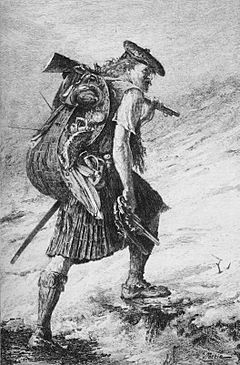
The use of Scottish language in writing continued after 1745, most famously by Robert Burns. But others avoided recent divisions in Scottish society by looking back to a more distant and often mythical past. This included James Macpherson. Between 1760 and 1765, he published the Ossian cycle, which was very popular across Europe. The claim that it was translated from original Gaelic has been debated ever since. But the feeling after 1746 that a culture was under threat led to a rise in Scottish Gaelic literature. Much of this was about the events of the rebellion. Alasdair mac Mhaighstir Alasdair, who wrote the first non-religious works in Gaelic in the early 1740s, was followed by other Gaelic poets. These included Donnchadh Bàn Mac an t-Saoir, who fought in the rebellion for the government, and Catriona Nic Fhearghais, who reportedly lost her husband at Culloden.
The rebellion has been a popular topic for writers like D. K. Broster and Sir Walter Scott. Scott's 1814 novel Waverley presented it as part of a shared history that supported the Union. The hero of Waverley is an Englishman who fights for the Stuarts. He rescues a government colonel and chooses a Lowland aristocrat's daughter over a romantic Highland beauty. Scott's way of bringing together Unionism and the '45 allowed Cumberland's nephew, George IV, to be painted less than 70 years later wearing Highland dress and tartans. These had previously been symbols of Jacobite rebellion.
Replacing a complex and divisive past with a simpler, shared culture led to Victorian traditions like Burns Suppers, Highland Games, and tartans. It also led to a largely Protestant nation adopting Catholic figures like Mary, Queen of Scots and Bonnie Prince Charlie as cultural icons. These traditions continue to shape how people see Scotland's past today.
|


